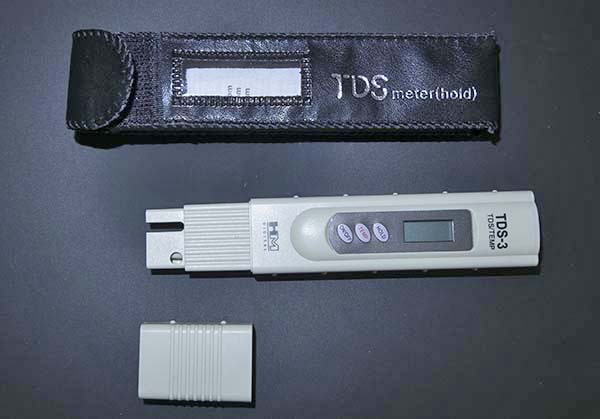HM TDS-3 — handheld "total dissolved solids" aquarium meter — thermometer function review
© 2017 Peter Free
14 December 2017
Caveat — thermometer function review only
I am using HM's TDS-3 meter in a fresh water, rather than salt water aquarium. I have not used its total dissolved solids function. This review only covers the thermometer component.

Not bad as a thermometer, but with couple of mildly annoying drawbacks
On the positive side, the meter reads in Celsius or Fahrenheit. That's great.
It also seems to be ballpark accurate. As compared to my aquarium heater's programmed range, as well as to the house thermostat — which is located just 2.5 meters from the aquarium.
Negatively, however, HM thought it would be wise to put a fixed shirt pocket, rather than an aquarium clip on this plastic meter. Consequently, the clip is too high to hook it securely to an aquarium side, without having the meter risk being immersed too far into the water.
HM says maximal immersion should be only 2 inches (about 5 centimeters). Using the clip, I can get mine to teeter right at that maximal immersion depth. It would be nice if the clip were located a little farther down on the meter, so that I would not consistently have to flirt with drowning its electronics.
The above glitch would not matter, if the thermometer read temperature fairly quickly. But it doesn't.
I have leave mine in the water for about 5 minutes to be sure that it has reached equilibrium. The thermometer is slow to begin with, and then it drags like near-frozen molasses as it creeps up (or down) the final tenths of degree Fahrenheit.
In short, only the most patient users are going to hand hold this thermometer while it does its work.
Were these engineering drawbacks avoidable?
I think so.
First, why would the average aquarist walk around with a meter clipped into his or her (usually non-existent) shirt pocket?
Would not a thoughtful engineer foresee that a slow-reading meter should have an aquarium clip built into it?
Second, why does the meter read so slowly?
I used to have mercury and mechanical photo chemical meters that sprinted up to accurate readings much more quickly. I also own a current technology digital (human ear temperature) thermometer that spits out reasonably accurate readings within 3 seconds.
Why the above two drawbacks matter — in practical application
One of the major uses for an aquarium thermometer is to calibrate between two (or more) aquariums.
It is risky to take fish from higher or lower temperature pools of water and abruptly dump them into a different temperature range. Because my sample of the TDS-3 reads temperature so slowly — (yes, with its protective cap removed) — checking two water sources takes forever.
In illustration of this inconvenience, I found the HM product tedious to use after a friend gave me a betta fish in a small bowl. This was before I had cycled the aquarium that the betta was going to inhabit.
The bowl required frequent water changes. And that meant that I had to check to see that new water (sourced from a faucet and treated with anti-chlorine drops) matched the bowl temperature.
While the molasses-like TDS-3 leisurely took its serial two readings, the new water would be warming or cooling. That meant that the (new water) HM thermometer readings were initially always out of date.
It was easier and more accurate just to wait for the new water to equilibrate with the old.
Given temperature differences throughout the house, I carried the new water to the bowl's location and waited for about an hour for the new water to reach ambient temperature there.
In short, the TDS-3 thermometer was useless for efficient water temperature comparisons under the above circumstances.
Mechanical photo chemical thermometers would have accurately done these water temperature comparisons in a jiffy. Which is, incidentally, something that film processing often requires. The HM could not.
Where the HM thermometer function is useful
I use the TDS-3 to keep track of my aquarium heater's functioning.
For that purpose, the meter's slowness is not a significant drawback. I just have to be sure that its too high clip has not allowed the meter to dip too far into the water.
The moral? — The HM TDS-3 is an okay (but not ideal) aquarium spot check thermometer
Based on internet reviews, it appears that the meter's total dissolved solids function is why the majority of people buy it.
It certainly would not be difficult for a competing manufacturer to top the TDS-3's utility as a thermometer.
 PeteFree.com
PeteFree.com